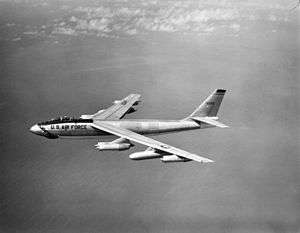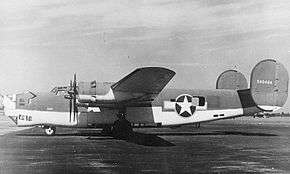361st Tactical Missile Squadron
| 361st Tactical Missile Squadron | |
|---|---|
 Strategic Air Command B-47 Stratojet | |
| Active | 1942-1944; 1958-1962 |
| Country |
|
| Branch |
|
| Role | Antisubmarine, Bombardment |
| Engagements |
European Theater of Operations Mediterranean Theater of Operations |
The 361st Tactical Missile Squadron is an inactive United States Air Force unit. It was formed by the consolidation of the 1st Antisubmarine Squadron and the 661st Bombardment Squadron
History
World War II
The squadron was organized in Utah, then formed in Washington state and began training as a Second Air Force bombardment unit flying patrols in the northwest with Boeing B-17 Flying Fortresses, it was prepared for deployment to England as an Eighth Air Force heavy bombardment Squadron.[1]
Moved to Langley Field, Virginia, it converted into a Consolidated B-24 Liberator antisubmarine unit, being redesignated the 1st Antisubmarine Squadron. It deployed to RAF St Eval in England as part of the 1st Antisubmarine Group (Provisional); it trained with RAF Coastal Command on aerial antisubmarine tactics.

The squadron deployed to Port Lyautey in French Morocco in March 1943 to shore up scanty Allied antisubmarine defenses in the Atlantic approaches to the Straits of Gibraltar. It was part of the 2037th Antisubmarine Wing (Provisional) under the operational control of the United States Navy Fleet Air Wing 15, which answered to the commander of the Moroccan Sea Frontier.
The squadron flew antisubmarine hunter killer missions from Morocco, deploying to stations in Tunisia in September 1943. It operated 24 hours a day until the landing of the United States Fifth Army at Salerno, Italy. It extended antisubmarine patrols until 9 September to cover the sea west of Sardinia and Corsica. One B-24 destroyed three German flying boats northwest of Sardinia. In addition to the antisubmarine patrols, the 1st Squadron flew escort for several Allied convoys and covered the escape of Italian naval vessels from Genoa and Spezia to Malta following Italy's surrender. Both the 1st and 2nd Antisubmarine Squadrons made-up the 480th Antisubmarine Group under the command of Colonel Jack Roberts. In June 1943, the group was assigned to the Northwest African Coastal Air Force under the command of Air Vice-Marshal Hugh Lloyd, RAF, but the group operated under the control of the USN FAW-15 at Port Lyautey, French Morocco, (now Kenitra, Morocco).
The squadron returned to Morocco on 18 September and operated in the Moroccan Sea Frontier until it returned to the United States in November 1943, it was inactivated in January 1944.
Cold War
From 1958, the Boeing B-47 Stratojet wings of Strategic Air Command (SAC) began to assume an alert posture at their home bases, reducing the amount of time spent on alert at overseas bases. The SAC alert cycle divided itself into four parts: planning, flying, alert and rest to meet General Thomas S. Power’s initial goal of maintaining one third of SAC’s planes on fifteen minute ground alert, fully fueled and ready for combat to reduce vulnerability to a Soviet missile strike.[2] To implement this new system B-47 wings reorganized from three to four squadrons.[2][3] The 661st was activated at Pease Air Force Base as the fourth squadron of the 509th Bombardment Wing.[4] The alert commitment was increased to half the squadron's aircraft in 1962 and the four squadron pattern no longer met the alert cycle commitment, so the squadron was inactivated on 1 January 1962.[3][5]
Lineage
- 1st Antisubmarine Squadron
- Constituted as the 361st Bombardment Squadron (Heavy) on 28 January 1942
- Activated on 15 July 1942
- Redesignated: 1st Antisubmarine Squadron (Heavy) on 23 November 1942
- Disbanded on 29 January 1944[6]
- Reconstituted and consolidated with the 661st Bombardment Squadron, Medium as the 361st Tactical Missile Squadron on 19 September 1985[7]
- 661st Bombardment Squadron
- Constituted as the 661st Bombardment Squadron, Medium on 1 December 1958
- Activated on 1 March 1959
- Inactivated on 1 January 1962
- Consolidated with the 1st Antisubmarine Squadron on 15 September 1985 as the 361st Tactical Missile Squadron[7]
- Consolidated Squadron
- Formed on 15 September 1985 by consolidation of the 1st Antisubmarine Squadron and the 361st Tactical Missile Squadron (inactive)[7]
Assignments
- 304th Bombardment Group, 15 July 1942 (air echelon attached to VIII Bomber Command after c. 10 November 1942)
- 25th Antisubmarine Wing, 30 December 1942 (air echelon attached to VIII Bomber Command until 15 January 1943), (attached to 1st Antisubmarine Group (Provisional) until l March 1943, 2037th Antisubmarine Wing (Provisional))
- 480th Antisubmarine Group, 21 June 1943 – 29 January 1944[6]
- 509th Bombardment Wing, 1 March 1959 – 1 January 1962[4]
Stations
- Salt Lake City Army Air Base, Utah], 15 July 1942
- Geiger Field, Washington, 15 September 1942
- Ephrata Army Air Field, Washington, 1 October 1942
- Langley Field, Virginia, 29 October-26 December 1942 (operated from RAF St Eval, England after 10 November 1942)
- RAF St Eval (Sta 129),[8] England, 13 January 1943
- Port Lyautey, French Morocco, 9 March-27 November 1943 (operated from Agadir, French Morocco, July 1943, Protville Airfield, Tunisia, 2–18 September 1943
- Clovis Army Air Field, New Mexico, c. 4–29 January 1944[6]
- Pease Air Force Base, New Hampshire, 1 March 1959 – 1 January 1962[4]
Aircraft
- Boeing B-17 Flying Fortress 1942
- Consolidated B-24 Liberator, 1942-1944[6]
- Boeing B-47 Stratojet, 1958-1962[4]
References
- Notes
- ↑ Maurer, Combat Squadrons, p. 3
- 1 2 Schake, p. 220 (note 43)
- 1 2 "Abstract (Unclassified), History of the Strategic Bomber since 1945 (Top Secret, downgraded to Secret)". Air Force History Index. 1 April 1975. Retrieved 4 March 2014.
- 1 2 3 4 Ravenstein, p. 276
- ↑ See Ravenstein, p. 276 (end of assignment to 509th Wing).
- 1 2 3 4 1942-1944 lineage, including assignments, stations and aircraft, in Maurer, Combat Squadrons, p. 3
- 1 2 3 Department of the Air Force/MPM Letter 662q, 19 Sep 85, Subject: Reconstitution, Redesignation, and Consolidation of Selected Air Force Tactical Squadrons
- ↑ Station number in Anderson.
Bibliography
![]()
- Anderson, Capt. Barry (1985). Army Air Forces Stations: A Guide to the Stations Where U.S. Army Air Forces Personnel Served in the United Kingdom During World War II (PDF). Maxwell AFB, AL: Research Division, USAF Historical Research Center. Archived from the original (PDF) on 23 January 2016. Retrieved 7 July 2012.
- Ferguson, Arthur B. (April 1945). "The AAF Antisubmarine Command, AF Historical Study No. 107" (PDF). Assistant Chief Air Staff, Intelligence. Retrieved 17 February 2016. .
- Maurer, Maurer, ed. (1983) [1961]. Air Force Combat Units of World War II (PDF) (reprint ed.). Washington, DC: Office of Air Force History. ISBN 0-912799-02-1. LCCN 61060979. Retrieved 17 December 2016.
- Maurer, Maurer, ed. (1982) [1969]. Combat Squadrons of the Air Force, World War II (PDF) (reprint ed.). Washington, DC: Office of Air Force History. ISBN 0-405-12194-6. LCCN 70605402. OCLC 72556. Retrieved 17 December 2016.
- Ravenstein, Charles A. (1984). Air Force Combat Wings, Lineage & Honors Histories 1947-1977 (PDF). Washington, DC: Office of Air Force History. ISBN 0-912799-12-9. Retrieved 17 December 2016.
- Schake, Col Kurt W. (1998). Strategic Frontier: American Bomber Bases Overseas, 1950-1960 (PDF). Trondheim, Norway: Norwegian University of Science and Technology. ISBN 978-8277650241. Retrieved 27 July 2015.
- Warnock, Timothy. "The Battle Against the U-Boat in the American Theater" (PDF). Bolling AFB, DC: Air Force History Support Office. Retrieved 22 June 2015.
External links
- "Sub Hunters Return". Time Magazine. 20 December 1943. Retrieved 28 March 2017. (Introduction only, full article requires subscription)